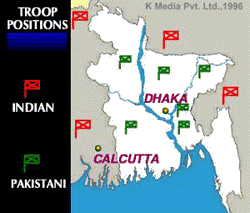For all practical
purposes, the war started at about 5:40 pm on 3 December when
Pakistan Air Force (PAF) combat aircraft struck nine Indian
airfields along the Western borders. The air strikes were
followed by a massive attack on the strategic Chhamb sector in
the north. In the East, it was the Indian Army which went on the
offensive. By late that night, artillery shells were raining down
all along the Western and Eastern borders. India and Pakistan
were locked in a two-front war.
Acting in
accordance with its strategy to grab as much territory in the
West as possible, Pakistan also launched a major attack on Punch
in the state of Jammu & Kashmir. This attack, unlike the one
on Chhamb, was completely repulsed, although here the Indian Army
was at a locational disadvantage since the Pakistanis controlled
the heights around the town. Smaller attacks were launched by
Pakistan in Punjab at Fazilka and Hussainiwala. Here the forward
Indian defences were breached but the Pakistani Army could not
sustain its attacks. A more ambitious armoured thrust in the
deserts of Rajasthan was similarly stopped in the famous Battle
of Longewal. In all, it appeared that the Pakistani military high
command could not make up its mind as to where it should deliver
its main punch and kept pulling back until it was too late.
| The
Indian Army chief, General Sam Maneckshaw, had a
completely different set of problems. His strategy had to
take into account the Chinese, with whom the Indian Army
had fought a full blown war only nine years earlier. The
Chinese were now firm Pakistani allies and had been
making threatening noises ever since India resolved to
intervene in the East Pakistan issue. General Maneckshaw,
despite the disappointment of his Corps and divisional
commanders, had to hold back his Army in the West, keep a
watchful eye on the long and difficult Chinese borders
and, at the same time, ensure that his Eastern Army
secured its objective of grabbing a good chunk of East
Pakistani territory within 2 to 3 weeks. The Indian aim
was to install a Bangladeshi interim government in East
Pakistani territory before the cessation of hostilities.
|
 |
| The 4th morning saw Indian forces and Mukti Bahini
guerrillas ready for battle with the Pakistanis, who were
by now well dug in and waiting for the Indian assault.
The Indian forces easily outnumbered the Pakistanis by a
ratio of about 2:1. However, according to conventional
infantry wisdom, an attacking Army requires a
three-is-to-one superiority in numbers to attack. India
did not have that. Besides, the Pakistani Army commander
in the East, General A.A.K.Niazi, was determined merely
to delay the Indian advance. For, in this war, the real
battle was against time. The longer it took the Indian to
secure their limited objectives, the greater the
probability of the United Nations intervening to stop the
war and effect a stalemate. Pakistan was confident that a
stalemate was all that the Indians could get. Towards
this strategy, General Niazi, had fortified the towns and
approaches to the East Pakistani heartland and had
boasted before the war began that should hostilities
begin, he would take the battle inside India. |
 |
The brief given by the Indian Army chief, General Maneckshaw,
to the Eastern Command was very limited. The aim was to occupy
only two areas of East Pakistan - Chittagong and Khulna - so that
an interim Bangladeshi government could be established. The
capture of the whole of East Pakistan was not even conceived.
The immense practical problem of moving thousands of troops
and tonnes of equipment across rivers and marshes was
accomplished largely due to the efforts of the Army Corps of
Engineers, and with a lot of local help. The IAF chipped in by
using helicopters to lift entire battalions across larger rivers
that could not be quickly bridged by the Engineers. In most
places, the swiftly moving contingents quickly overcame enemy
resistance and moved forward. The Pakistanis for the most part,
were completely taken by surprise.Within 6 days of the war,
Indian troops were deep inside East Pakistani territory and
moving fast. The Mukti Bahini section of the advancing forces
played a crucial role in guiding the Indian Army through the
treacherous riverine areas and providing critical intelligence.
The 4th morning saw Indian
forces and Mukti Bahini guerrillas ready for battle with the
Pakistanis, who were by now well dug in and waiting for the
Indian assault. The Indian forces easily outnumbered the
Pakistanis by a ratio of about 2:1. However, according to
conventional infantry wisdom, an attacking Army requires a
three-is-to-one superiority in numbers to attack. India did not
have that. Besides, the Pakistani Army commander in the East,
General A.A.K.Niazi, was determined merely to delay the Indian
advance. For, in this war, the real battle was against time. The
longer it took the Indian to secure their limited objectives, the
greater the probability of the United Nations intervening to stop
the war and effect a stalemate. Pakistan was confident that a
stalemate was all that the Indians could get. Towards this
strategy, General Niazi, had fortified the towns and approaches
to the East Pakistani heartland and had boasted before the war
began that should hostilities begin, he would take the battle
inside India.

